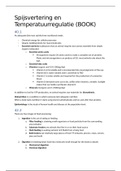Spijsvertering en
Temperatuurregulatie (BOOK)
40.1
An adequate diet must satisfy three nutritional needs:
Chemical energy for cellular processes
Organic building blocks for macromolecules
Essential nutrients (substances that an animal requires but cannot assemble from simple
organic molecules)
o Essential amino acids
All organisms require 20 amino acids to make a complete set of proteins.
Plants and microorganisms can produce all 20, most animals only about the
half.
o Essential fatty acids
o Vitamins (organic and 0.01-100mg/day)
Vitamin A is fat soluble and is incorporated into visual pigments of the eye
Vitamin B2 is water soluble and is converted to FAD
Vitamin C is water soluble and required for the production of connective
tissue
Vitamin D demands turns out to be, unlike other vitamins, variable. Sunlight
makes that our bodies synthesize vitamin D.
o Minerals (inorganic and 1-2500mg/day)
In addition to fuel for ATP production, an animal requires raw materials for biosynthesis.
Malnutrition is a condition in which someone lack adequate nutrition.
When a body lacks nutrition it starts using stored carbohydrates and fat, and after that proteins.
Epidemiology is the study of human health and disease at the population level.
42.2
There are four stages of food processing:
1. Ingestion is the act of eating or feeding.
a. Filter feeding is straining small organisms or food particles from the surrounding
area (whales)
b. Substrate feeders are animals that live in or on their food source
c. Fluid feeding is sucking nutrient rich fluids from a living host
d. Bulk feeders eat relatively large pieces of food tentacles, pincers, claws, venom,
jaws and teeth
2. Digestion is breaking down food into molecules small enough for the body to absorb
a. Mechanical digestion
b. Chemical digestion
, c. Intracellular digestion is breaking down food by enzymes in food vacuoles. A cell
engulfs solid food by phagocytosis or liquid food by pinocytosis (instulpen en
afsnoeren).
d. Extracellular digestion is the breakdown of food in compartments that are
continuous with the outside of the animal’s body. A gastrovascular cavity is een
verteringsstelsel met één opening dus mond = anus. More complex animals have a
complete digestive tract = alimentary tract, a digestive tube with two openings;
mouth and anus.
3. Absorption
4. Elimination: material passes out of the digestive system.
42.3
There are three pairs of salivary glands, as well as three individual glands:
Pancreas
Liver
Gallbladder
Oral cavity and esophagus
The oral cavity is the start of food processing, besides the mechanical digestion, salivary glands
release saliva. A major component of saliva is mucus, a viscous mixture of water, salts, cells and
slippery glycoproteins. Saliva contains amylase as well, which breaks down starch (glucose polymer
in plants) and glycogen (glucose polymer in animals). The tongue helps detecting food and forming it
into a ball; the bolus. Each bolus of food is received by the pharynx (= throat region; esophagus and
trachea). At the end of the esophagus, the food enters a sphincter which is a ring like valve of
muscle.
Stomach
After the oral cavity and the esophagus food comes into the stomach which stores and digests. The
stomach secretes a digestive fluid called gastric juice, the mixture with food is called chyme.
HCl disrupts the extracellular matrix that binds cells together. Due to the HCL the pH is 2, which helps
denature proteins and exposing their peptide bonds.
There are two types of cells in the lumen which produce gastric juice: parietal cells (expel H into the
lumen when meanwhile CL ions diffuse into the lumen) and chief cells (release pepsinogen which is
activated to pepsin by HCL, after pepsin itself can activate more pepsinogen).
Churning are the coordinated series of contractions and relaxations of the stomach.
Small intestine
Most chemical digestion begins in the small intestine, the alimentary canal’s longest compartment
(6m in human). The first 20cm forms the duodenum, here chyme from the stomach mixes with
digestive juices from the pancreas, liver and gallbladder, as well as from gland cells of the intestinal
itself. The arrival of chyme triggers the release of the hormone secretin, which stimulates the
pancreas to secrete biocarbonate which neutralizes the pH.
Fats form a problem, because they are insoluble in water. Bile from the liver contain bile salts which
acts as emulsifiers, besides that, bile contributes to the destruction of red blood cells that are no
longer fully functional. Jaundice is yellowing due to the accumulation of bile in the skin.
The jejunum and the ileum make up the remaining parts of the small intestine and are responsible
for food absorption. Depending on the nutrient transport across the membrane can be active or
passive. Capillaries and veins that carry out nutrient rich blood convergent into the hepatic portal






